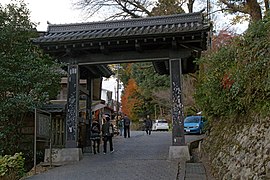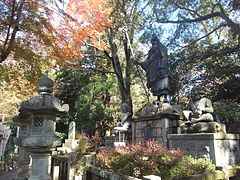Kimpusen-ji
The Kimpusen-ji ( Japanese 金峯 山寺 ) is one of the most important temples of the syncretistic religion of Shugendō . It is located in the mountain region of Yoshino ( Yoshino-yama ) in the municipality of Yoshino ( Nara prefecture ), which has long been famous for its cherry blossom . The name "Gold Summit Mountain" ( Kimpusen ) designates the entire region including the mountain Ōmine (Ōmine-san in Japanese 大 峰山 ), which is considered to be a spiritual mountain landscape. Today it is registered as a World Heritage Site within the framework of the Kumano-Yoshino National Park.
history
According to legendary tradition, the temple was founded in the 7th century by the mountain ascetic En no Gyōja (also En no Ozunu). Historically clearer traces reach back to the Heian period . According to the "correct tradition of the monk Shōbō " ( Shōhō-sō silk , 聖 宝 僧 正 伝 ), the Shingon monk Shōbō , called Rigen Daishi (832-909), restored the temple complex in 892, erected Zaō statues, laid out pilgrimage routes and founded several smaller temples in the area. The temple was therefore under the influence of Shingon Buddhism ( Shingon-shū ) for a long time . In the Edo period , the temple was placed under the order of the Shogun Tokugawa Ieyasu of the Tendai school ( Tendai-shū ) in 1614 .
With the beginning of the Meiji period , the new government banned the syncretistic practices of Shugendo as part of the forced separation of Shinto and Buddhism ( Shinbutsu-Bunri ). The Kimpusen temple and a number of branch temples in the area were disbanded, and in some cases also demolished. It was not until 1886 that the Tendai School allowed it to start up again. After the Second World War, the temple became the main temple of a Shugendo branch (Kimpusen Shugen Honshū 金 峯山 修 験 本 宗 ).
Temple area
You enter the inner temple area through the temple gate Niōmon ( 仁王 門 ; national treasure ), which was rebuilt in 1456 .
The main hall, also called Zaō-hall ( Zaō-dō , 蔵 王 堂 ), has the dimensions 7 × 8 Ken , here 25.76 × 27.27 m (width × depth) and a height of 34 m, making it the second highest after the main hall of the Tōdai Temple ( Tōdai-ji ) in Nara . The building is two-story and has a hipped roof covered with wooden shingles. The current hall dates from 1592 and is also registered as a national treasure.
The temple complex also includes the “Black Gate” ( 黒 門 , Kuromon ), the “Aizen Hall” ( 愛 染 堂 , Aizen-dō ,), the “Kannon Hall” ( 観 音 堂 , Kannon-dō ), the “Itoku Shrine” “( 威 徳 天 満 宮 , Itoku Tenmangū ).
In the "Hall of the Original Shape" ( Honjidō 本地 堂 ), which was built behind the main hall in the 20th century, there are statues of the three original shapes of Avatar Zaō, namely Miroku , Senshu- Kannon Bosatsu and Shaka Nyorai. On the left there is a statue of En no Gyōja . This hall is usually not accessible and is used for various ceremonies.
In 1963 a temple building called Nanchō Myōhōden ( 南朝 妙法 殿 ) was built with a statue of Shaka Nyorai to commemorate the four Tennō of the "Southern Court" ( Nanchō ) who lived during the "Epoch of the North and South Courtyards" ( Nambokuchō -jidai, 1336 –1392) resided in Yoshino and blessed the temporal here.
In the immediate vicinity we find a devotional building with a relic of Shaka Nyorai ( Busshari Hōden 仏 舎 利 宝殿 ), which the temple received in 1967 from the Indian Prime Minister Indira Gandhi .
From there, a long stone staircase leads to the "Dragon God Temple" ( 脳 天大 神 龍王 院 , Nōten-ōkami ryūō-in ) in a narrow valley floor. In addition to the prayer hall and a number of mini-shrines there is a building in which one can undergo “waterfall retreats” ( takigyō ).
Treasures
The “Zaō Hall” houses the main deity, the Avatar Zaō ( 蔵 王 権 現 , Zaō Gongen ) in three forms that represent the future, present and past: Senshu-Kannon Bosatsu (6.15 m high) and Shaka Nyorai (7.28 m) and Miroku Bosatsu (5.92 m). The imposing cobalt blue statues were previously not shown as "Hidden Buddhas" ( hibutsu ). Today the shrines are opened to the general public on certain dates.
A number of sculptures, some of which are valuable, from smaller temples in the area, which were abandoned during the early Meiji period, stand along the two side walls behind the chancel.
A bronze lamp in the demarcated area in front of the main hall dates from 1471 and is designated as an “important cultural asset”. According to tradition, Prince Moriyoshi , son of Emperor Go-Daigo , held a final banquet under the four cherry trees in the same square in 1333 before the attack of the Hōjō clan's troops.
Important festivals
The frog hopping ceremony takes place on July 7th . The performance is based on the legend that a monk was turned into a frog because of his pride and could only be redeemed by the powers of the monks of Mount Yoshino.
photos
Statue of En no Gyōja (En no Ozunu)
literature
- Nara-ken kotogakko-kyoka token kenkyu-kyokai rekishi bukai (Ed): Yoshino . In: Nara-ken no rekishi sampo (ge). Yamakawa Shuppan, 2010. ISBN 978-4-634-24829-8 .
Web links
- Japan-guide.com website Kimpusen-ji - English
- Website Kimpusen-ji - Japanese
- Live camera with a view of the Zaō hall (click the Japanese link below the photo)
Remarks
Coordinates: 34 ° 22 ′ 6.2 " N , 135 ° 51 ′ 29.3" E














